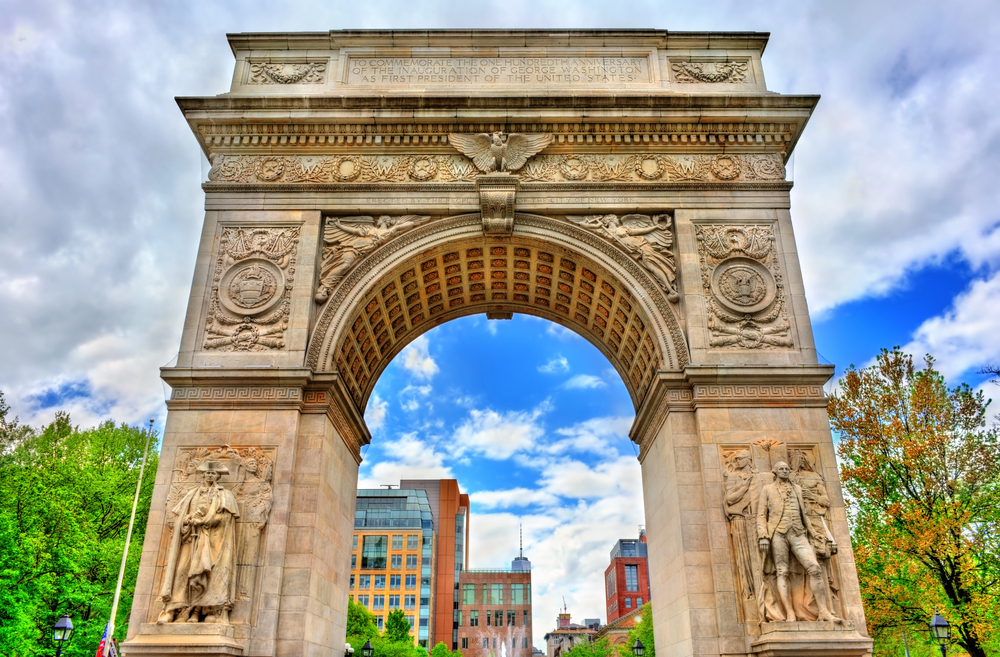Washington Square Park has a whole lot of history for a little park in Greenwich Village. From old burial grounds to protests and performances, this place has seen it all. It turns out there’s a whole fascinating story behind this hangout spot..
Early History
Before becoming a park, the area was a swampy, marshy piece of land with a stream running through it. Native Americans used to hunt there.
In the late 1700s, the city turned the land into a cemetery for poor people who died of yellow fever. They called it a “potter’s field.” There was a big tree used for public hangings they called the “Hangman’s Elm.”
In 1826, the city cleaned up the cemetery and renamed it Washington Military Parade Ground. Then in 1827, they turned it into one of New York’s first public parks.
Redesigning the Park
Just a year later in 1827, the space became a public park, one of the city’s first. Swanky residential enclaves soon sprouted up around the park, with wealthy families wanting to live near the fashionable green space. Talk about prime real estate!
In 1870, the newly formed Department of Public Parks gave the Square a major makeover. Landscape architects followed the design ideals of Central Park’s Frederick Law Olmsted, adding curving walkways and open lawns. I don’t know about you, but I’d love to go back in time to see the elegant Victorian ladies and gents strolling about.
Building the Iconic Arch
The next big milestone was the addition of the iconic Washington Square Arch. In 1889, a temporary wooden arch was constructed to celebrate the 100th anniversary of Washington’s inauguration. How cool would that centennial celebration have been?
After receiving acclaim, the temporary arch was replaced with a permanent marble one in 1892, designed by architect Stanford White. Fun fact: the Arch is modeled after the Arc de Triomphe in Paris. Fancy!
It wasn’t until 1916 and 1918 that statutes of Washington were installed in the Arch’s niches, completing its majestic look. The Arch has become such a symbolic monument, it’s hard to imagine the park without it!

Protests and Performances
In the 1900s, the park became a gathering spot for protests and music performances. People marched through the Arch to protest working conditions after a nearby factory fire killed many women.
In the 1950s and 60s, Beat poets like Allen Ginsberg used the park as a hangout while Bob Dylan played guitar by the fountain with friends – how cool is that?
The park even played a role in preserving its own future. Residents rallied against imposing traffic or redesign plans proposed by the infamous city planner Robert Moses, ultimately keeping the Square car-free and maintaining its local vibe.

Battles to Protect the Park
Speaking of preservation controversies, Washington Square Park has seen its fair share over the decades. In the 1920s, committees fought to retain the low scale of buildings around the park when taller apartments threatened the landscape. cracks knuckles It was on.
Battling Robert Moses’ plans from the 1930s-60s was just one part of the preservation story. Residents also opposed NYU expansion encroaching on the park, starting in the 1940s. And who can forget the victory in having the Greenwich Village historic district designated in 1969? Milestones like that are worth celebrating.
Even in recent decades, attempts to alter the park have been met with resistance. Changes to the fountain location or plaza layout in the 2000s redevelopment plans drew community pushback. But ultimately compromises were reached to keep the park’s spirit intact. Phew!
Today: Heart of the Village
Today the park remains a beloved community space, with its iconic Arch, fountain, lawns and walkways. After everything it’s been through, Washington Square Park continues to be the heart of Greenwich Village.
source https://sesamorestaurant.com/news/washington-square-park-then-and-now/
No comments:
Post a Comment